
Animals, as cute as some of them may be, can be a source of illness for humans. These so-called zoonotic diseases can originate from bacteria, viruses, parasites or fungi. In fact, most infectious diseases that plague people can be spread by animals. More than six in every 10 known infectious diseases in people can come from animals, while three out of every four new diseases in people originally come from animals, according to the Centers for Disease Control and Prevention(CDC).
From rabies to fish tank granuloma, here are 32 diseases that you can catch from animals… but hopefully won't.
1. Rabies

When an infected animal bites another animal, or a person, they can transmit this nervous system ailment. Rabies takes time to pass to the brain, which is when people show symptoms like fever or headache, which progress to delirium, hallucinations and abnormal behavior. The disease is almost always fatal once symptoms appear, though it can be prevented if animals are vaccinated. In the U.S., rabies is most common in wild animals — think bats, skunks and foxes. But dogs still carry it in other countries, and they're behind most human deaths from the disease, according to the CDC.
2. Trichinosis
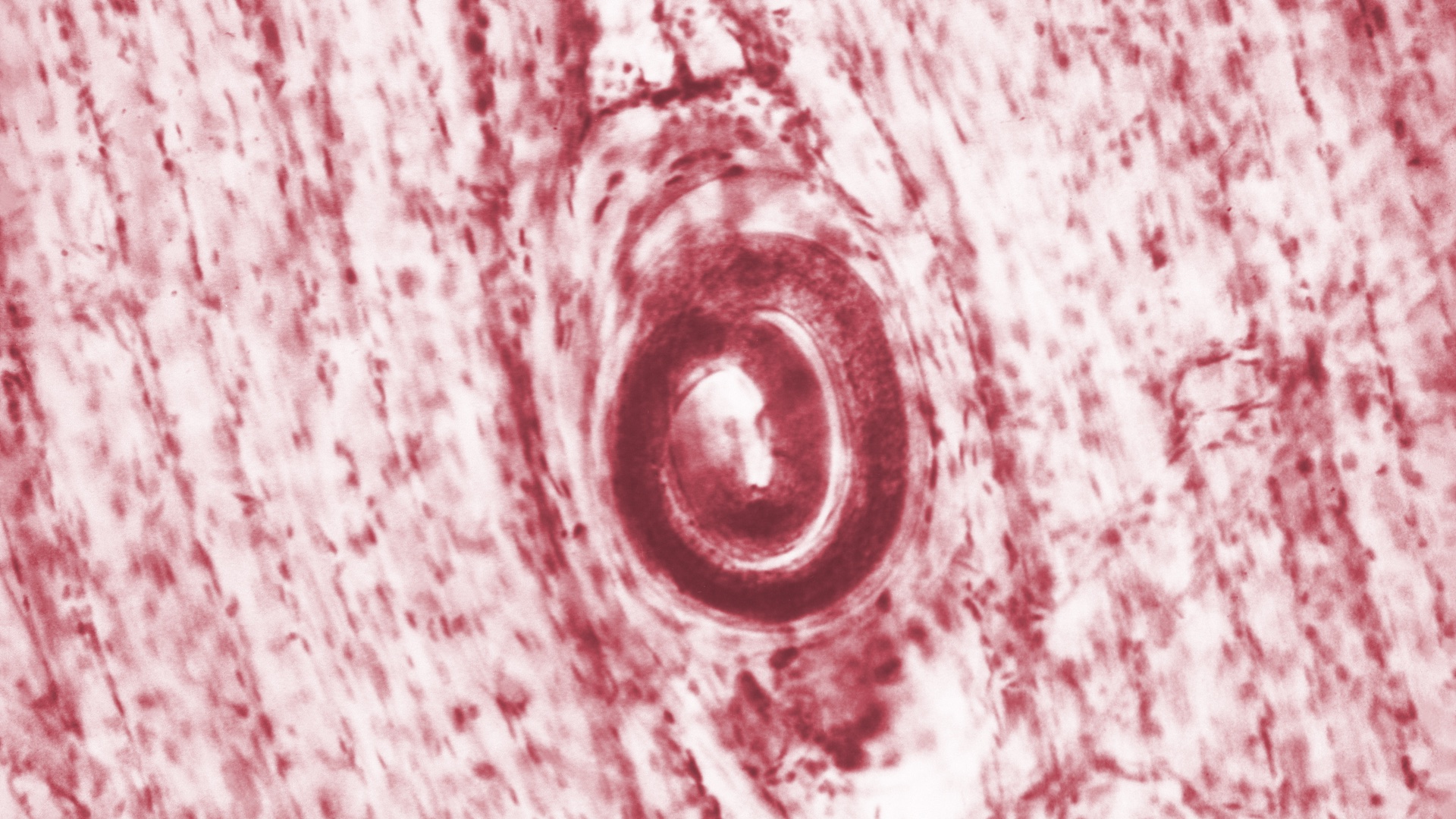
Trichinosis, also known as trichinellosis, passes to humans when they eat undercooked or raw meat that carry the larvae of the roundworm Trichinella spiralis. It particularly affects bears, cougars, wild boars and pigs, according to the CDC. Though death from trichinosis is rare, it's possible. Usually, initial symptoms include diarrhea, nausea, vomiting, stomach pain, fever and fatigue; they can progress to aching joints, itchy skin, constipation and cough. In fact, most people may pass it off as a flu. Trichinosis is diagnosed with a blood test or muscle biopsy, and prescription medications can treat it. About 20 cases a year pop up in the U.S., so it's not common but worth noting, according to the CDC.
3. Cat Scratch Disease

Your favorite feline is cute and fuzzy until they bite or scratch you — that's when you can potentially develop cat scratch disease, which is caused by the bacterium Bartonella henselae. Most people don't show any symptoms after being infected and get better without treatment. Fleas are the culprit here, as they spread the bacteria between cats. Kittens are more likely to have it than grown adult cats, and they're more likely to pass it to humans. A blood test can diagnose if you have it, and symptoms range from swollen lymph nodes to fever, headache, appetite loss and pustules near the wound. Antibiotics can help, but it usually resolves on its own — maybe unlike your relationship with the cat.
4. Ancylostoma caninum
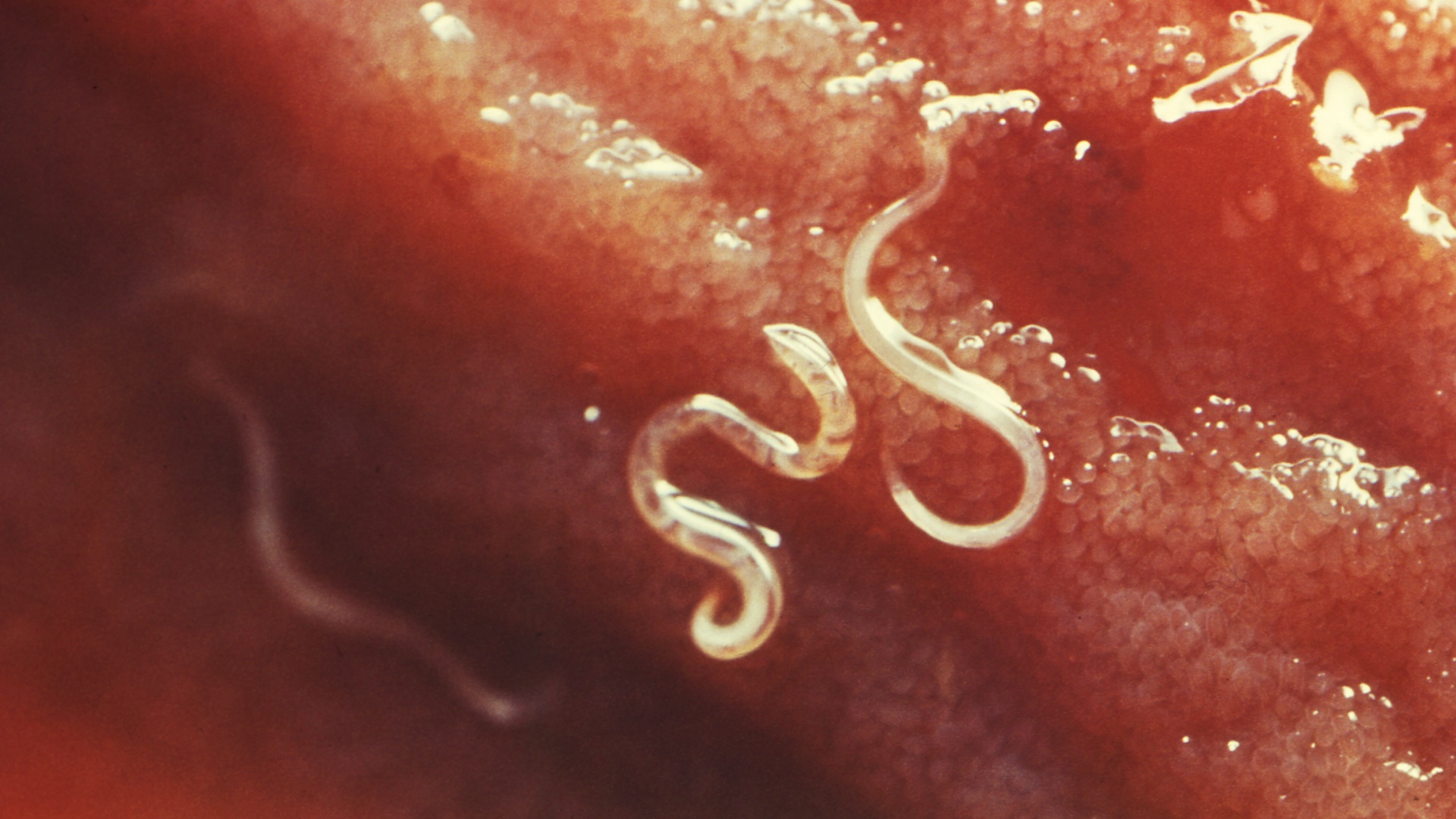
A variety of hookworm infections can pass from dogs and cats to humans — Ancylostoma caninum is just one type. The parasite's eggs are released into the environment when an animal defecates. Animals and humans can then become infected either by inadvertently eating them or touching them with unprotected, broken skin, according to the CDC. Most hookworm infestations lead to a skin condition known as "cutaneous larva migrans," which causes redness and itching. Over time, red tracks can appear that track the larvae's movement under the skin. Itching and pain can go on for several weeks until the larvae die and the reaction clears up. Regular deworming can help eliminate the worms from pets and thus lower the chances of the parasite getting into soil nearby, hopefully ensuring you never get this parasite.
5. Bird flu

Bird flu occurs if you're infected with the avian influenza type A viruses. These viruses regularly circulate in birds and other animals, but they normally don't affect humans. Infected birds can distribute the virus via their saliva, mucus and feces. In other animals, the virus may appear in organs, blood or bodily fluids, including milk. People can acquire bird flu by getting the virus in their eyes, nose or mouth, or by inhaling it. Touching something with the virus on it and then rubbing your eyes, for example, can also put it into your body. Doctors diagnose bird flu with a nasal swab, and medications are available that can treat it, according to the CDC. Symptoms can be mild, like a flu or cold, and include fever, body aches, nausea and diarrhea. However, some cases can be severe — between January 2003 and March 2024, nearly 890 cases of human infection with a bird flu subtype called H5N1 were reported in 23 countries, and 463 were fatal.
6. Herpes B

This one's super rare, but could happen if you regularly interact with macaque monkeys. The herpes B virus can be transmitted when an infected monkey bites or scratches a person. The virus is common in these monkeys, and it can be found in their saliva, urine, feces and brain or spinal cord tissue, according to the CDC. The virus can survive for hours on surfaces, which gives it more time to spread. In humans, symptoms can start out as flu-like and then progress to muscle coordination issues and difficulty breathing. The rare infection leads to death in an estimated 70% of untreated cases. If you do come down with herpes B, antivirals are available. Just one case has been reported where someone got this and gave it to another human, so at least if it happens it's just between you and the monkey.
7. Fish tank granuloma

Fish handlers, beware. Fish tank granuloma is a rare skin infection caused by Mycobacterium marinum, an organism found in stagnant saltwater and freshwater such as ponds and aquariums, according to the American College of Osteopathic Dermatology. Handling a fish tank or shucking oysters can put you at risk for this infection. The bacteria enters through the skin, but is not spread from person to person. Your doctor may suggest a skin biopsy to confirm a diagnosis. There are antibiotics that can help, though it can take up to two years to fully clear the infection.
8. Bubonic plague
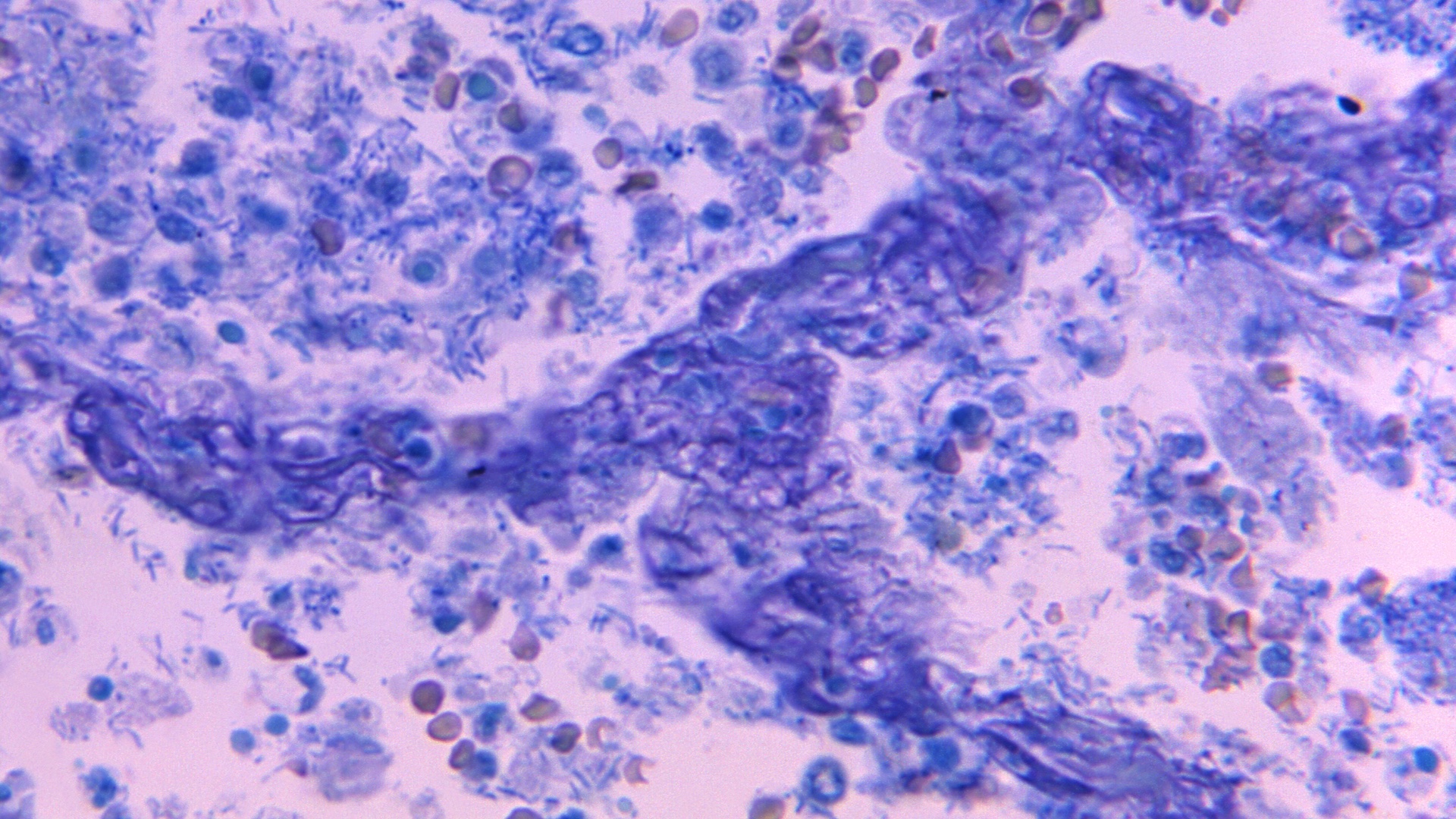
It may sound like a thing of the past, but the bubonic plague that sparked the famous Black Death epidemic still happens today. It's caused by the bacteria Yersinia pestis. Dogs, cats and rodents, such as rats and squirrels, can acquire the bacteria and spread it to humans that come in contact with their contaminated fluids or tissues. Most often, though, the microbe is transmitted to humans when they're bitten by a flea that's carrying it. Rarely, people can also get it from airborne droplets coughed out by an infected person, or by coming into contact with that person's bodily fluids. Fever, chills, weakness and swollen, painful lymph nodes are the main symptoms. Bubonic plague can still kill you if left untreated, but antibiotics can successfully cure the infection.
9. Cysticercosis

Cysts from the tapeworm Taenia solium can cause a parasitic infection known as cysticercosis. People get this by inadvertently swallowing eggs found in the feces of a person who has the tapeworm. Hand washing can help prevent its spread. Sometimes, noshing on raw or undercooked pork containing these cysts can also transmit the parasite. Blood tests can diagnose mild infections, while a magnetic resonance imaging (MRI) or computed tomography (CT) scan can be used to identify worms that have burrowed into the brain. Some people don't require treatment for cysticercosis, but it can cause symptoms such as seizures and other side effects in others, in which case medication can treat the infection.
10. Ebola
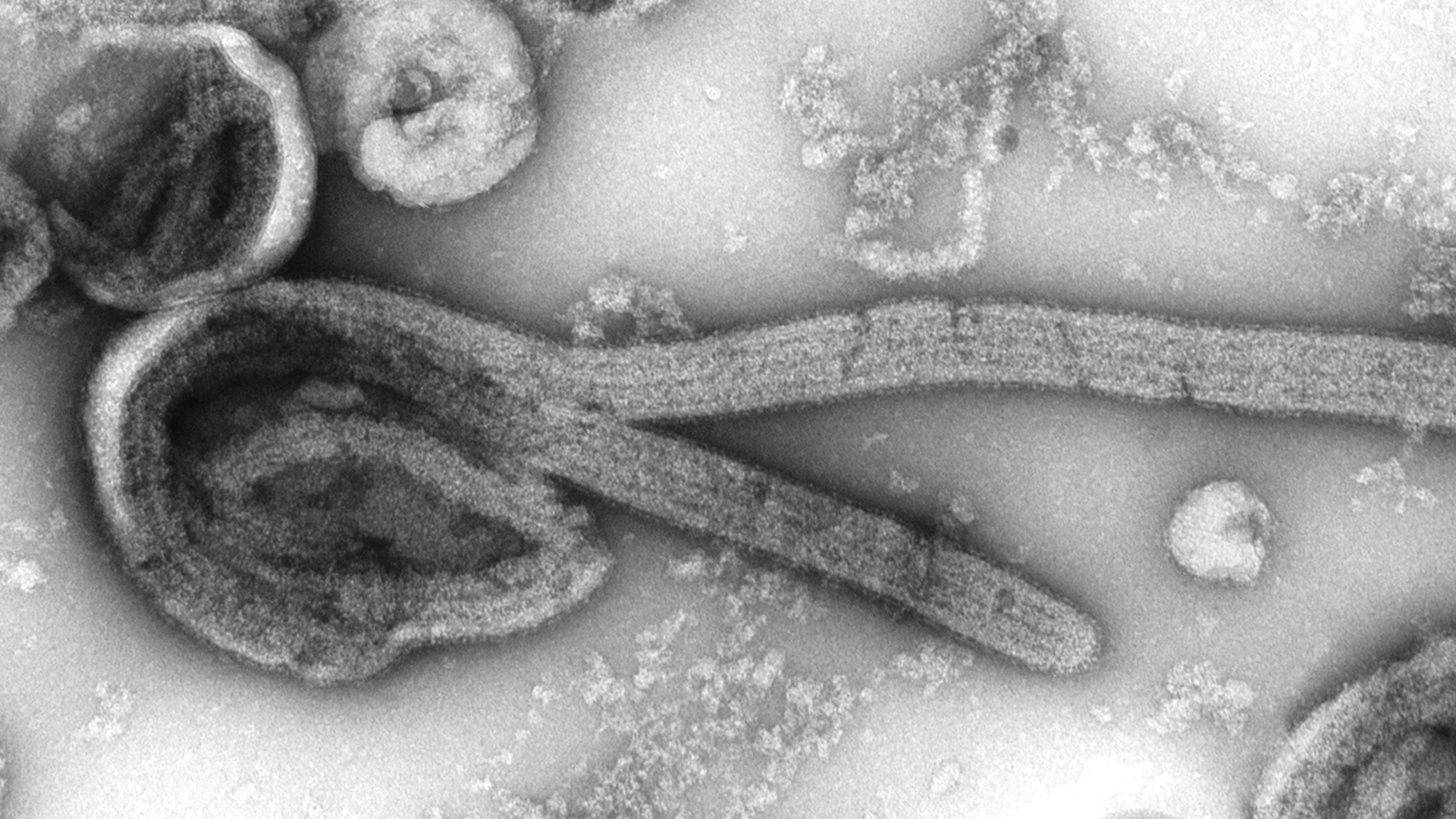
It's thought that the Ebola virus spreads to humans through close contact with the blood, bodily fluids or organs of these primates, as well as infected monkeys, fruit bats, forest antelope and porcupines, according to the World Health Organization. Sudden fever, weakness, sore throat, headache and vomiting are initial symptoms of infection in people; impaired kidney and liver function can follow, along with both internal and external bleeding. About half of all people who contract Ebola die from it, but early care can reduce the risk of death. The good news is that we have a vaccine that works against one strain of Ebola virus, and scientists are working to develop shots for the other strains.
11. Lyme Disease
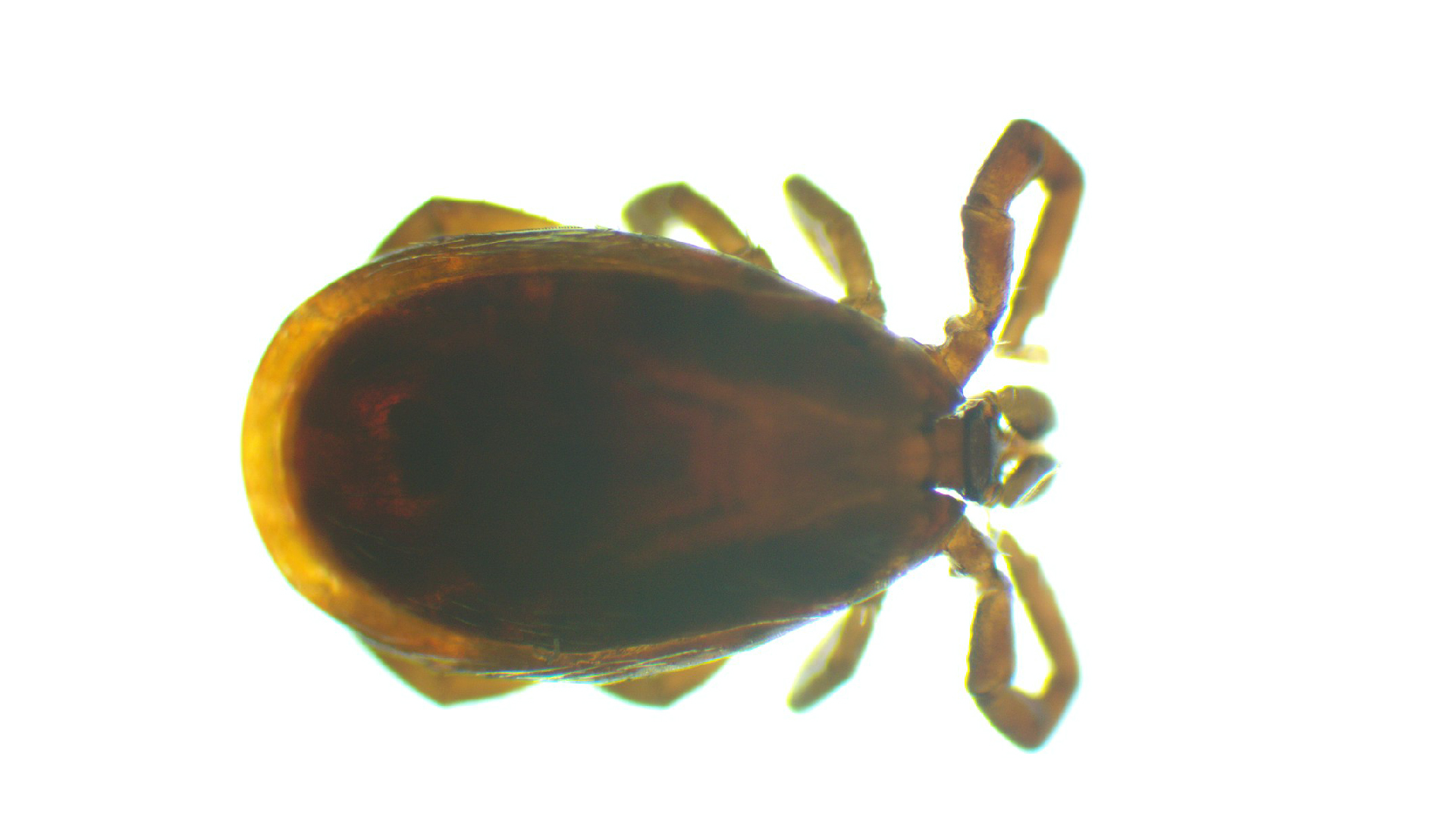
Tick bites can transmit the bacteria that causes Lyme disease. In the U.S., the bacterial culprit is typically Borrelia burgdorferi, but B. mayonii is sometimes to blame. Fever, fatigue, headache and a ring-like rash may accompany a bite. If left untreated, Lyme disease can affect your heart, joints and nervous system, and pain, fatigue or difficulty thinking can persist in Lyme patients for years. Doctors use a blood test to diagnose Lyme disease and, if you catch it early enough, antibiotics may be able to help treat the infection. The CDC estimates that about 476,000 people in the U.S. may be diagnosed with and treated for the disease each year.
12. Brucellosis

If you eat or drink unpasteurized dairy products or have an open wound, you can be at risk of Brucella infection, or brucellosis. The bacteria infect goats, cows, sheep, pigs, dogs and camels, getting into their bodies and milk. People working with the bacteria in labs are especially prone to this infection, as they can breathe in the microbe, and people who work in meat-packing plants and slaughterhouses are also vulnerable. The infection can't spread from person to person. Symptoms include malaise, anorexia, headache, depression, arthritis and fever, according to the CDC. Some symptoms can go away but others can recur. If you suspect that you have brucellosis, your doctor will conduct tests on blood, bone marrow or other body fluids. Antibiotics are available, but recovery can take a few weeks or months. The good news: death from the bacteria is rare.
13. Mad cow disease

Also known as bovine spongiform encephalopathy (BSE), mad cow disease affects cattle and causes progressive neurological problems in the animals. BSE is caused by prions, or abnormal, pathogenic forms of proteins that can cause normal proteins near them to misfold and malfunction. Cows can develop the disease if fed meal containing tissues from affected cows, or less commonly, they can develop it spontaneously. The human form of the disease is called Creutzfeldt-Jakob disease (CJD) and people can get it by eating food products made from infected cattle. The human disease leads to rapid dementia and neuromuscular disturbances that quickly get worse. It's super rare for people to get it, but worth a mention on this list because, as of a 2020 report, no person who has contracted CJD has survived.
14. Toxocariasis

The roundworm that causes toxocariasis can go from dogs and cats to humans, but not from human to human. Larvae from two species of Toxocara roundworms — T. canis from dogs and T. cati from cats — are shed in the animals' feces, and those eggs can be accidently swallowed by people if they touch their mouths with contaminated hands. You may not have symptoms if you pick up this parasite. That said, the infection can become systemic, in which case medications are available, while a form of the infection that affects the eyes is harder to treat, according to the CDC.
15. Echinococcosis

Echinococcosis is a parasitic disease caused by a tapeworm in the genus Echinococcus. The infection is classified either as cystic echinococcosis (CE) or alveolar echinococcosis (AE). The E. granulosus tapeworm that causes CE is found in dogs, sheep, goats and pigs. Most people that contract CE don't have symptoms but it can sometimes lead to enlarged cysts in the liver, lungs and other organs. Foxes, dogs and coyotes carry E. multilocularis, which causes AE. It's rare in humans but more serious than CE, and it can cause tumors and be fatal, according to the CDC.
16. Giardiasis
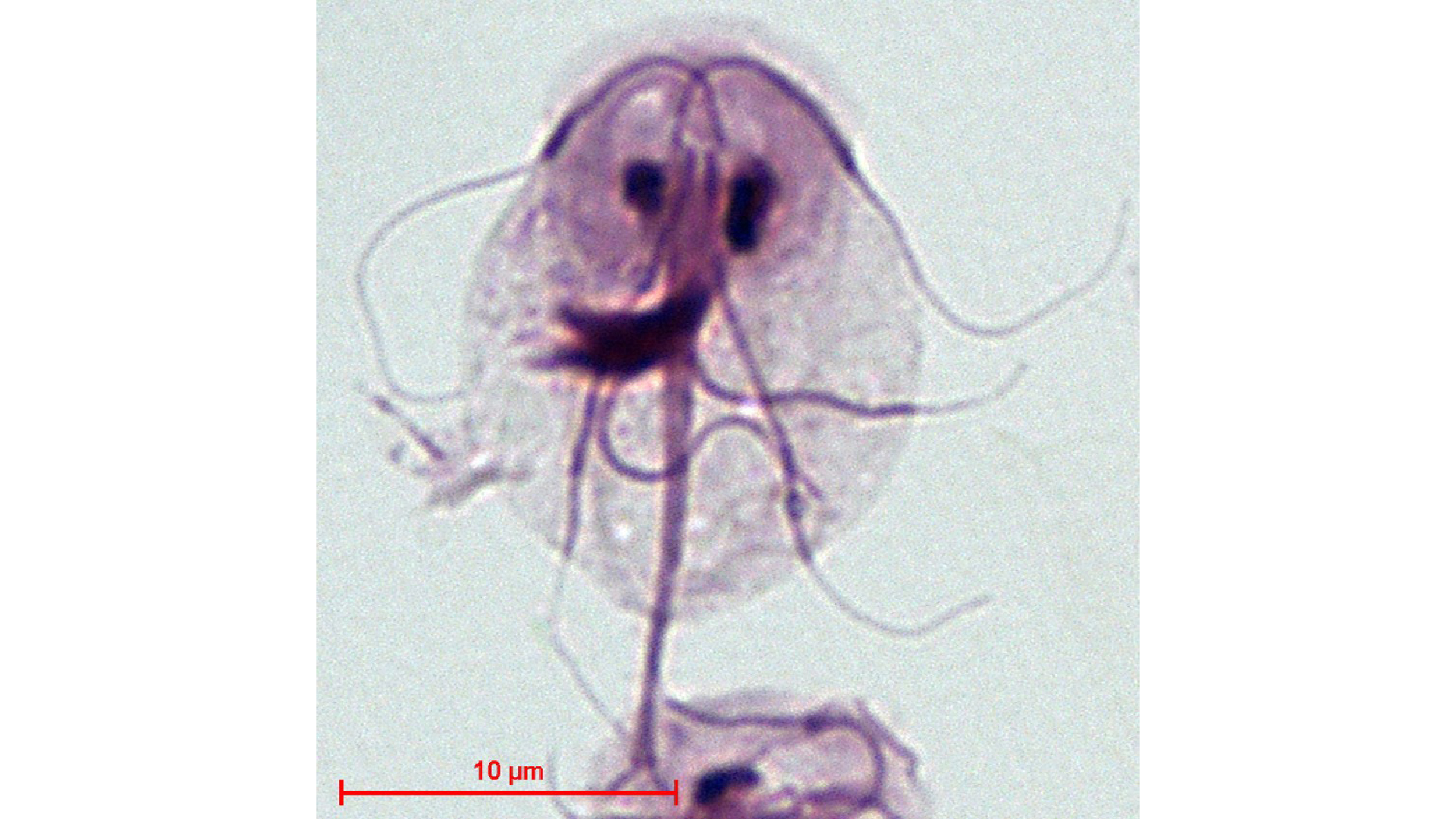
Giardia is a tiny parasite that causes the diarrheal disease giardiasis. You can pick it up from contaminated surfaces as well as from soil, food and water containing the feces of infected people or animals. The infection occurs worldwide. Some people have no symptoms while others have diarrhea, gas, greasy stools, stomach cramps, vomiting and dehydration within one to two weeks of infection, according to the CDC. Similar symptoms can emerge in pets and humans. There's a low risk of getting this parasite from your pet, but dog and cat stool can sometimes contain it.
17. Gnathostomiasis
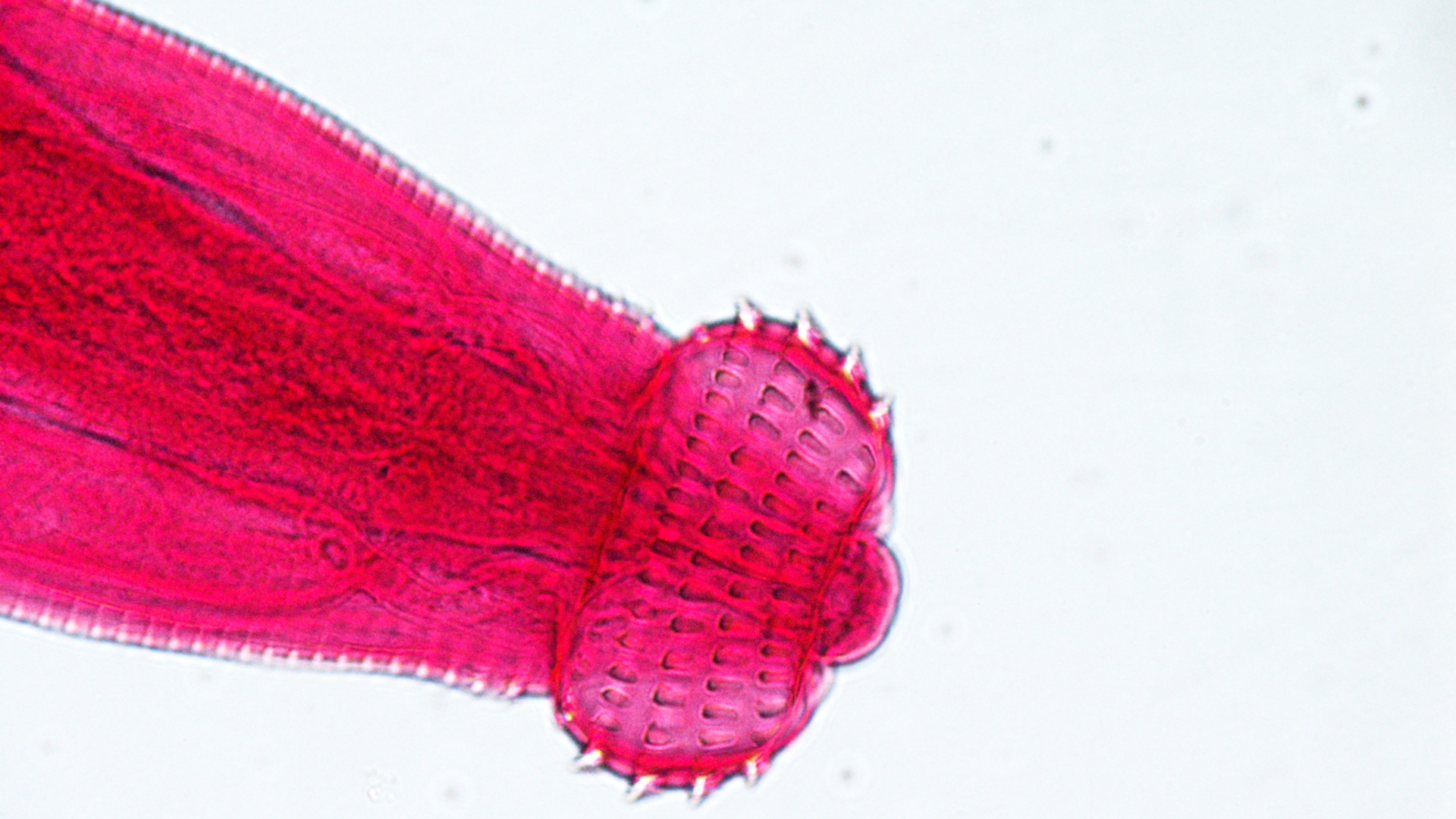
Parasitic worms in the genus Gnathostoma are the culprit behind gnathostomiasis. You can get it from eating raw or undercooked fish, birds, eels, frogs and reptiles, according to the CDC. The parasite reproduces in many mammals, including dogs, cats, opossums, raccoons, pigs, tigers, leopards, wild boars and weasels. The human infection causes swelling in the skin and increases the number of eosinophils, a type of white blood cell. In rare cases, it can cause blindness. Symptoms may be non-existent at first but can progress to fatigue, fever, vomiting, stomach pain and diarrhea. Doctors diagnose it with a blood test, and there are medications to treat it. The infection is most common in Southeast Asia, but it has also affected people in South and Central America, Asia and Africa.
18. Toxoplasmosis
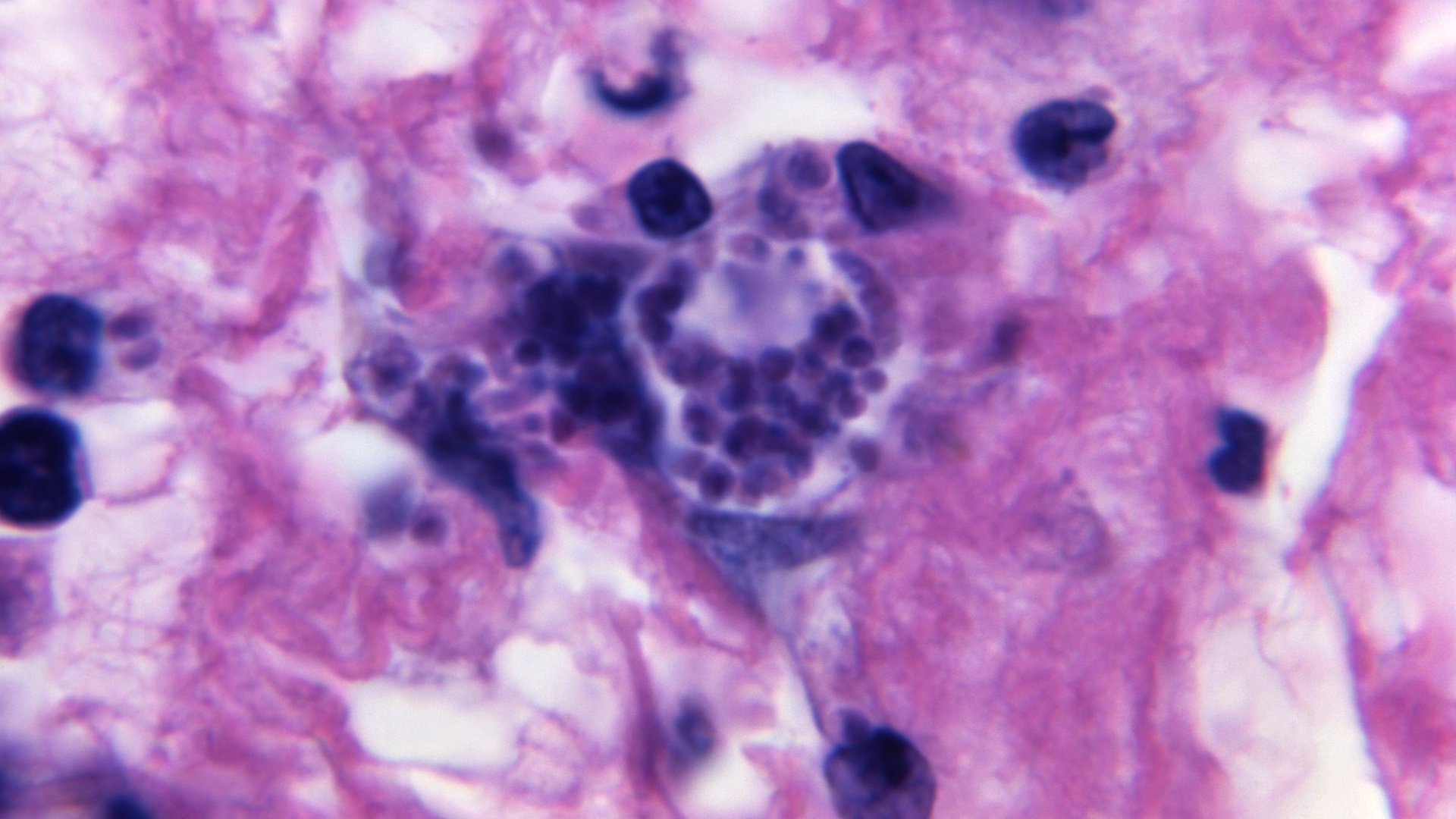
Toxoplasmosis is a result of the parasite Toxoplasma gondii, also known as the cat-poop parasite. The infection can be especially serious in people who get it before or during pregnancy, and in people who are immunocompromised. Some people infected by toxoplasma don't have symptoms; others feel like they have the flu, or experience swollen lymph nodes or muscle aches lasting for a month or more. Serious cases can impact the brain, eyes and other organs. Doctors use blood tests to diagnose it; some people don't need treatment but medications are available.
19. Swimmer's itch
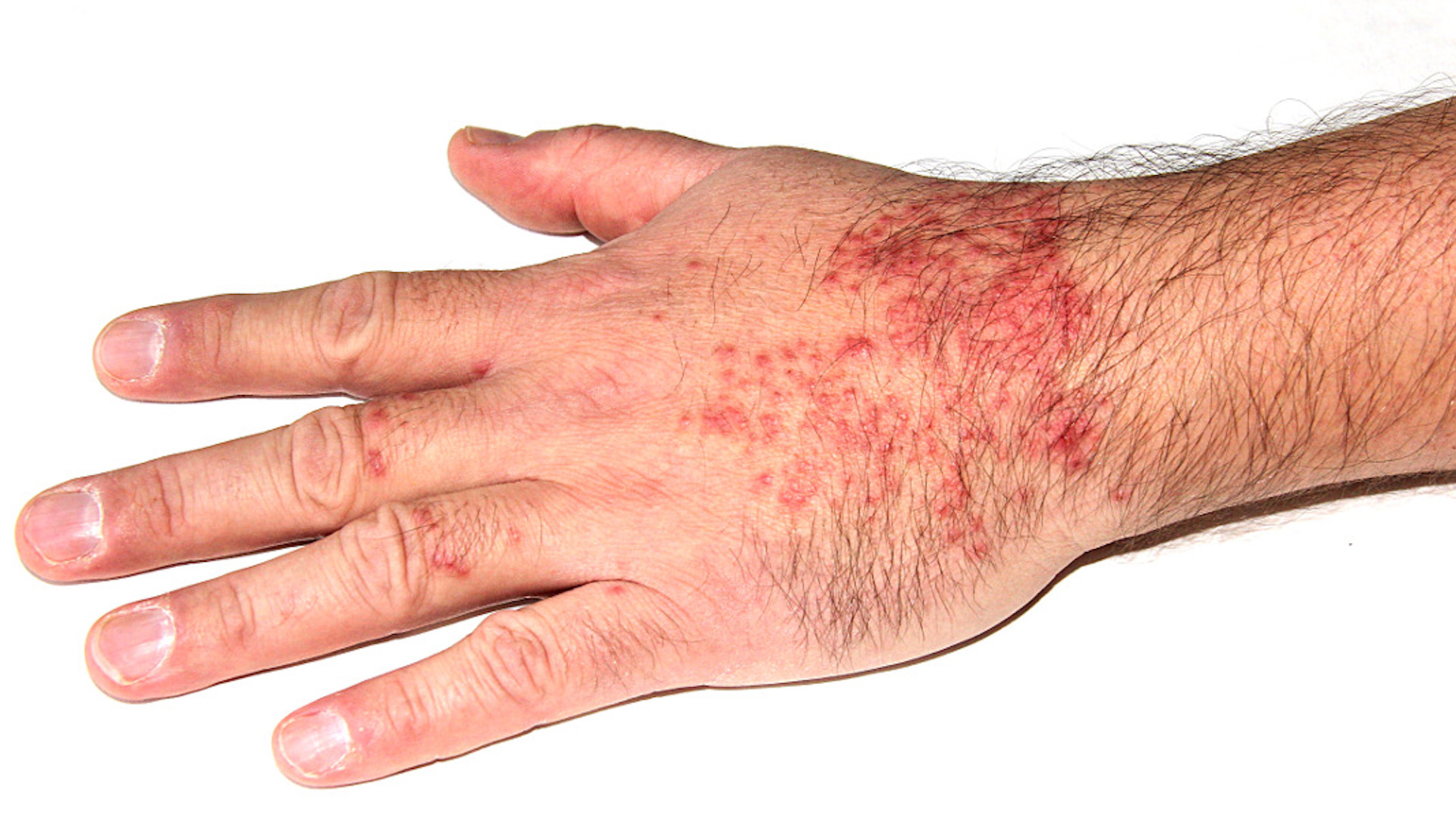
The technical name for swimmer's itch is cercarial dermatitis, though some also refer to it as duck itch or clam digger's itch. It happens when people are infected by parasites in the water near ponds and lakes, and many of the parasites are found in geese, ducks and muskrats. When the animals defecate, the eggs can enter water systems and then infect shallow-water snails. The snails then release the mature parasite into the water, which puts humans at risk. If you get it, you'll see a pimple-like rash where you touched the water. The rash can start within minutes or take up to two days to appear. Swimmer's itch does typically go away on its own, but there are treatments to relieve the discomfort.
20. Crypto

Many species of Cryptosporidium can infect animals, and some can be passed on to humans. These parasites are the culprit behind the diarrheal disease cryptosporidiosis, or "Crypto." It's caused by one tough parasite whose outer shell shields it from the effects of chlorine. The parasite can spread to people in a variety of ways, but drinking contaminated water is the most common. C. parvum and C. hominis are the most common species. Immunocompromised people can be more vulnerable to the infection and have more severe symptoms, which include stomach cramps, watery diarrhea, fever, nausea and vomiting, sometimes for several weeks. Doctors diagnose Crypto with a stool sample and typically won't need to treat it, though medication is available.
21. Leptospirosis
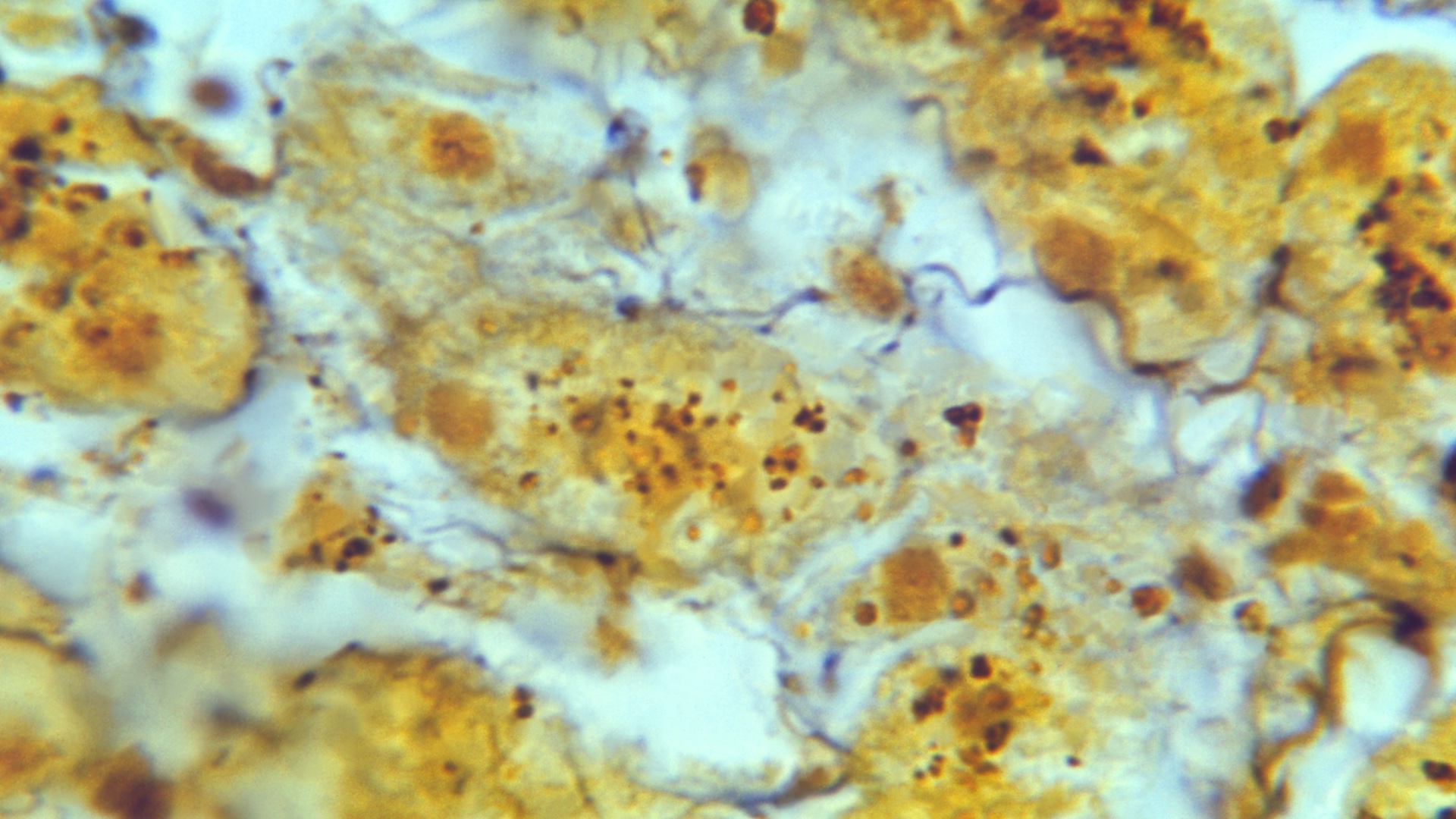
Dogs, rodents, cattle and other wild animals can carry bacteria from the genus Leptospira, which can cause leptospirosis in animals and humans. When animals urinate, the bacteria can get into the soil or water, where they can survive for several months. If you're exposed to contaminated water, the bacteria can then get into your eyes, nose or mouth, or enter your body through broken skin. The risk of infection often increases after a hurricane or flood, which can expose people to contaminated water. Animals may not have symptoms, but humans can experience fever, muscle aches, jaundice, stomach pain and rash. Leptospirosis can cause kidney damage, meningitis, liver failure and respiratory ailments, and it can be fatal. Antibiotics can treat the infection effectively.
22. Listeriosis
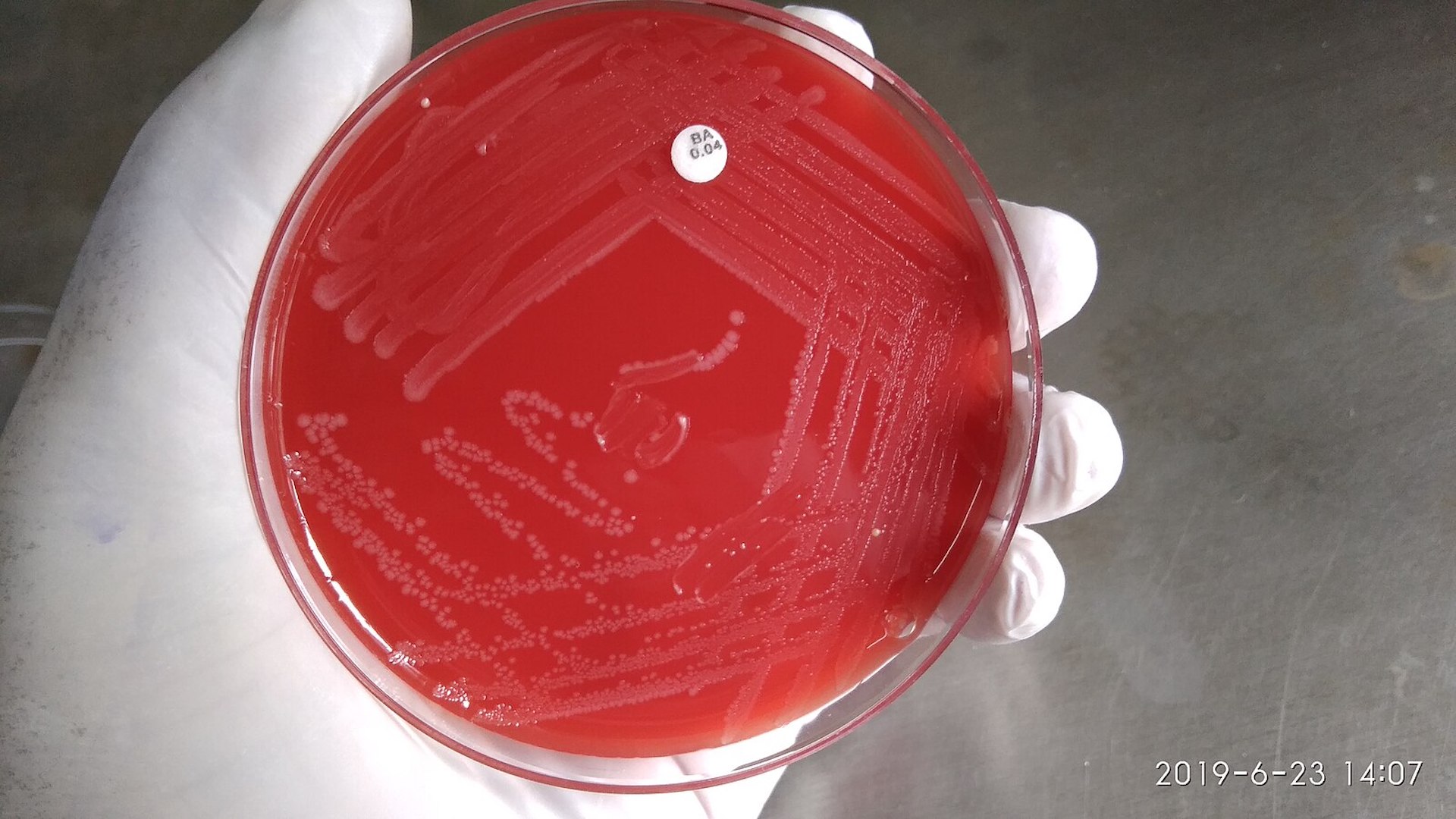
Listeriosis occurs when you eat food contaminated with the bacteria Listeria monocytogenes. Listeria outbreaks are fairly common, but don't necessarily affect huge numbers of people — about 1,600 people in the U.S. get the infection each year, 260 of whom die. People who are pregnant, newborns, people with weakened immune system and older people are most likely to get it. Flu-like symptoms are common, but more-serious symptoms can include confusion, vomiting, stiff neck and seizures. An intestinal form of the illness usually doesn't need antibiotics to clear up, but an invasive illness — when the bacteria passes outside of the gut — often requires medication to cure. Pay attention to the news; if there's an outbreak, it's often widely reported in the media so people know to watch out for it.
23. Rocky Mountain spotted fever
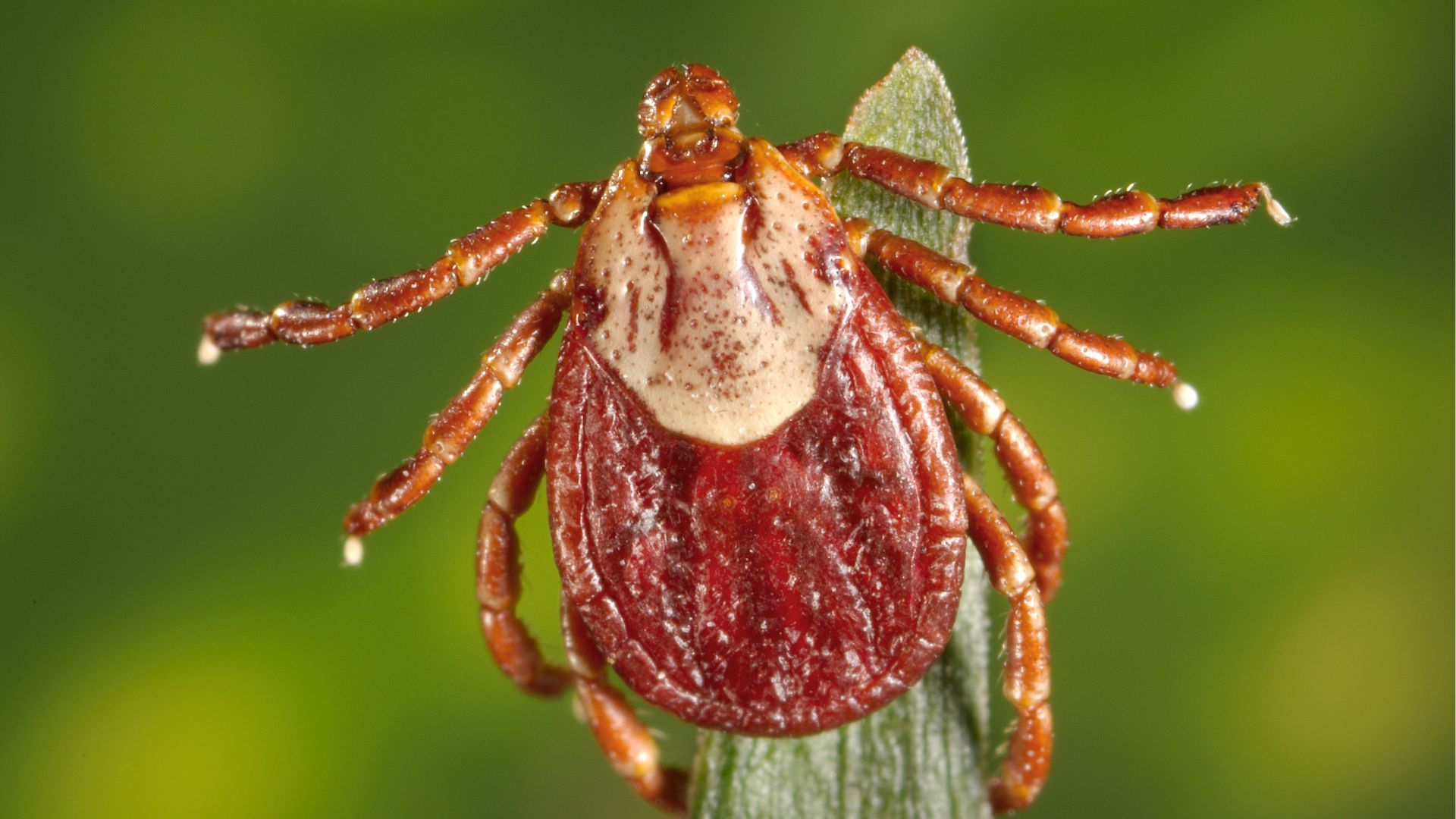
There's a reason experts caution us to pay attention if we're in an area with ticks, and Rocky mountain spotted fever is just one of them. Get bitten by a tick carrying Rickettsia rickettsii bacteria and you could be looking at a rash, fever and headache — and if you don't get the right antibiotic in your system, the infection can be deadly. The American dog tick (Dermacentor variabilis), Rocky Mountain wood tick (Dermacentor andersoni) and brown dog tick (Rhipicephalus sanguineus) can all spread Rocky Mountain spotted fever, and the illness is most commonly reported in North Carolina, Tennessee, Missouri, Arkansas and Alabama. Your doctor will do a blood test to make an official diagnosis; if you're positive, the illness can be treated with antibiotics.
24. Anthrax

You might first think of shady envelopes filled with mysterious white powders, but anthrax is actually caused by the bacteria Bacillus anthracis that can infect animals. However, it's rare to find infected animals in the U.S. People can get it by handling or consuming products from infected animals, or by breathing in spores found in animal hides, hair, wool or leather. Gastrointestinal infections can happen if you eat undercooked meat from infected animals. It doesn't spread between people. If you were to get anthrax, you'd be hospitalized and given antibiotics and antitoxin medications, as well as aggressive treatments like fluid drainage and ventilation if needed. The fatality rates differ depending on the route of exposure, but without treatment, the most fatal form — inhalation anthrax — is almost always fatal.
25. Zika virus

The Zika virus became a household name when it was spreading in the U.S. in 2015 and 2016. Mosquitoes of the genus Aedescan spread it, though it's not currently common in the U.S. The virus can pass into the womb during pregnancy, resulting in birth defects, such as microcephaly, in affected children. People can also spread Zika to one another through sexual contact. Typical symptoms include red eyes, rash, headaches, muscle pain and joint pain, although rarely, infections can affect the brain. Doctors use blood and urine tests to detect Zika virus. There aren't medications or vaccines for it, but people can treat the symptoms.
26. E. coli
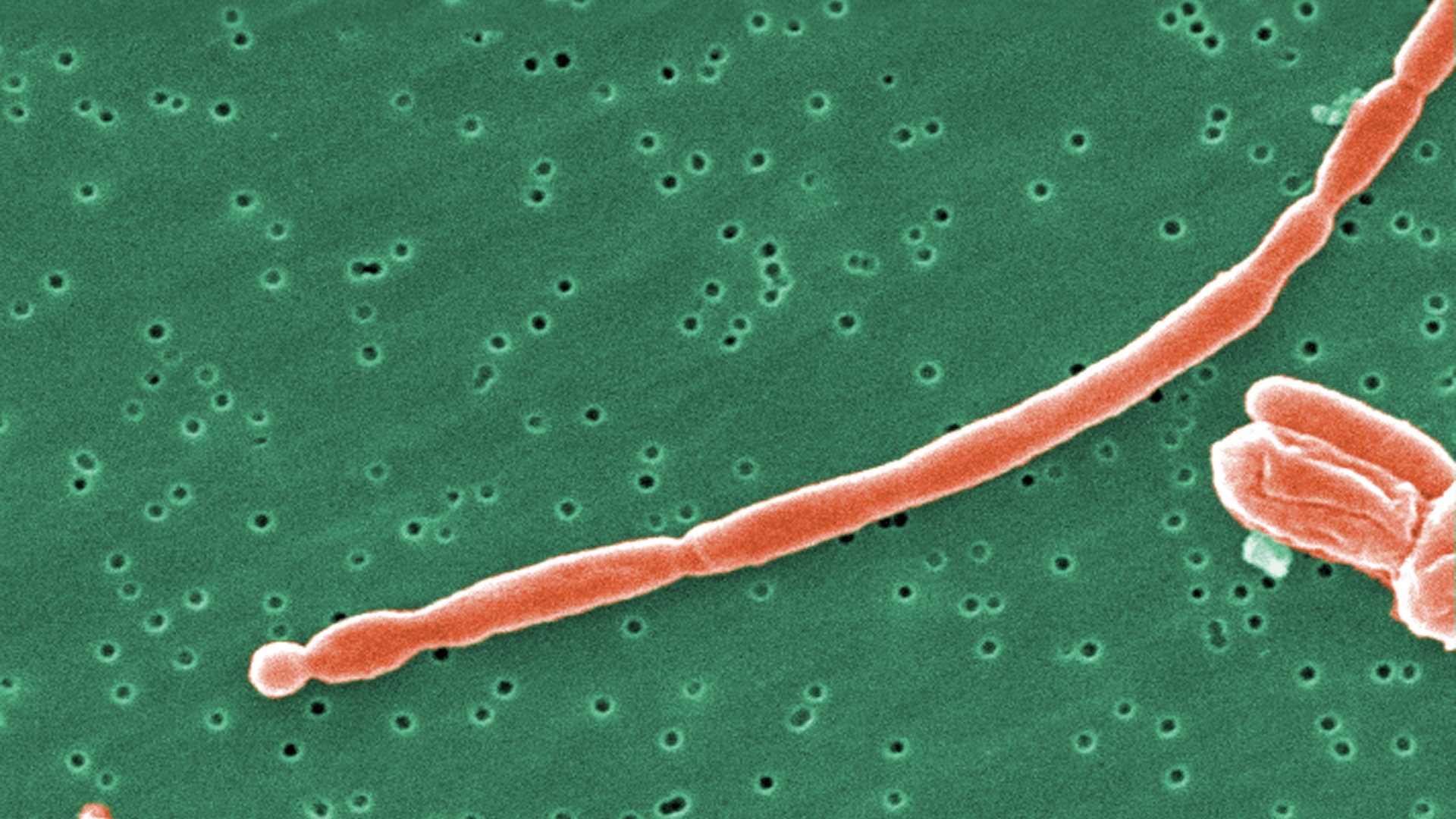
Escherichia coli, better known as E. coli, is a bacterium that normally lives in animals' and humans' intestines. It sheds when they defecate. Most strains of the bacteria won't hurt you, some can cause illness by making what's known as Shiga toxin. You can get E. coli by eating contaminated food or having direct contact with an animal or an item it's contaminated. Stomach cramping, vomiting, nausea and diarrhea can indicate that you've got the infection, which is contagious. Most people recover from the infection in about a week, although some cases can be deadly. Looking to prevent it? Cook your meats well, steer clear of unpasteurized dairy products or juice, wash raw produce and wash your hands regularly.
27. Hantavirus pulmonary syndrome
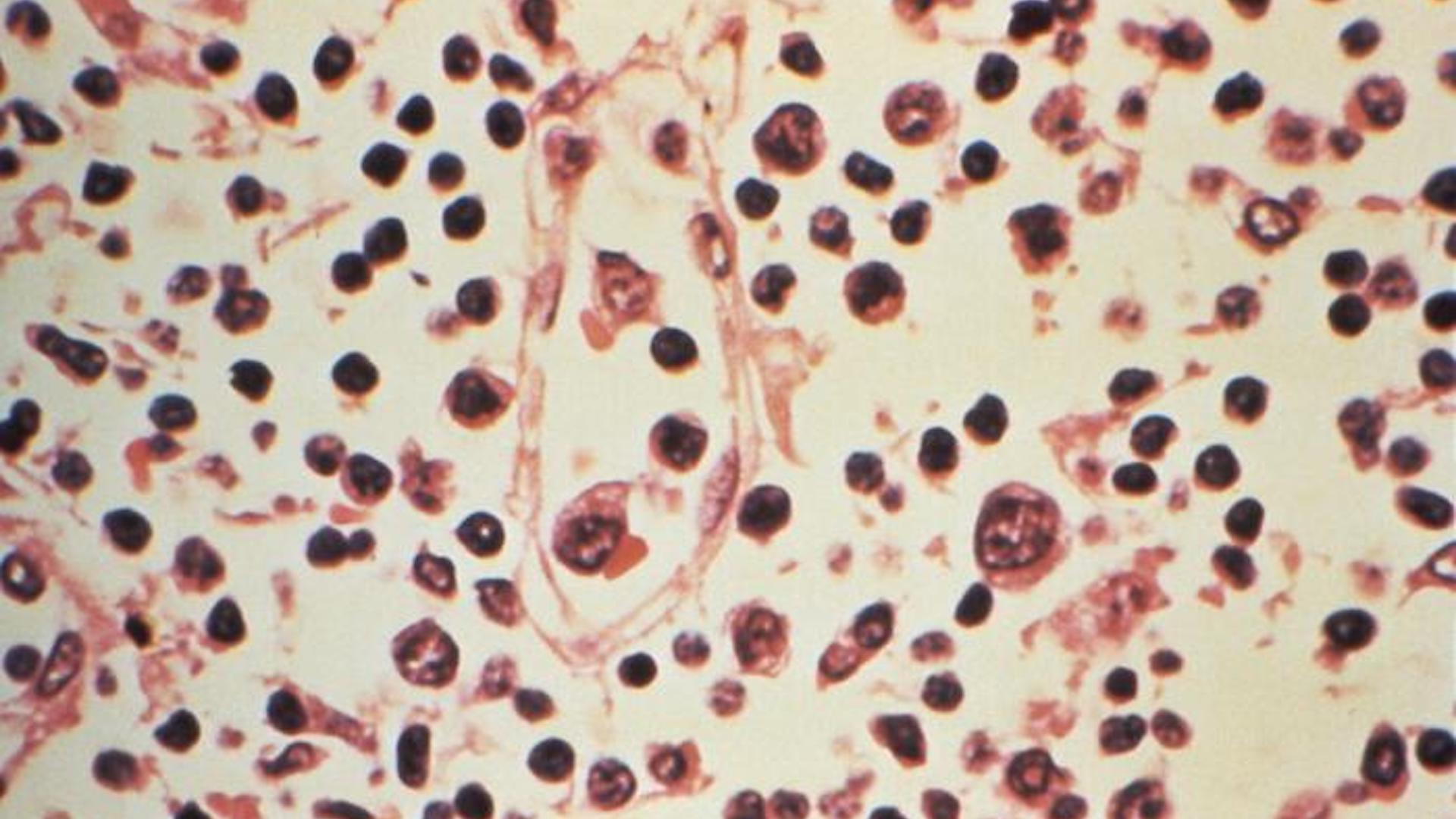
Rats and mice are the main animal reservoirs for hantaviruses, which can cause hantavirus respiratory syndrome. It most commonly occurs if you inhale dust that has been exposed to deer mice droppings, urine or saliva. Symptoms start similar to a mild flu, but your lungs can later fill with fluid and you'll have a hard time breathing as it gets worse. Most people recover, but there's no set treatment or vaccine for the virus. About one-third of all cases are fatal. Early diagnosis is key, as is access to an intensive care unit. Some people get oxygen to help them as they fight the infection. To avoid catching hantavirus, don't stir up rodent nests or other materials that have touched them, and keep rodents away from living areas. About 20 to 40 cases occur each year in the U.S., the CDC reports.
28. Psittacosis
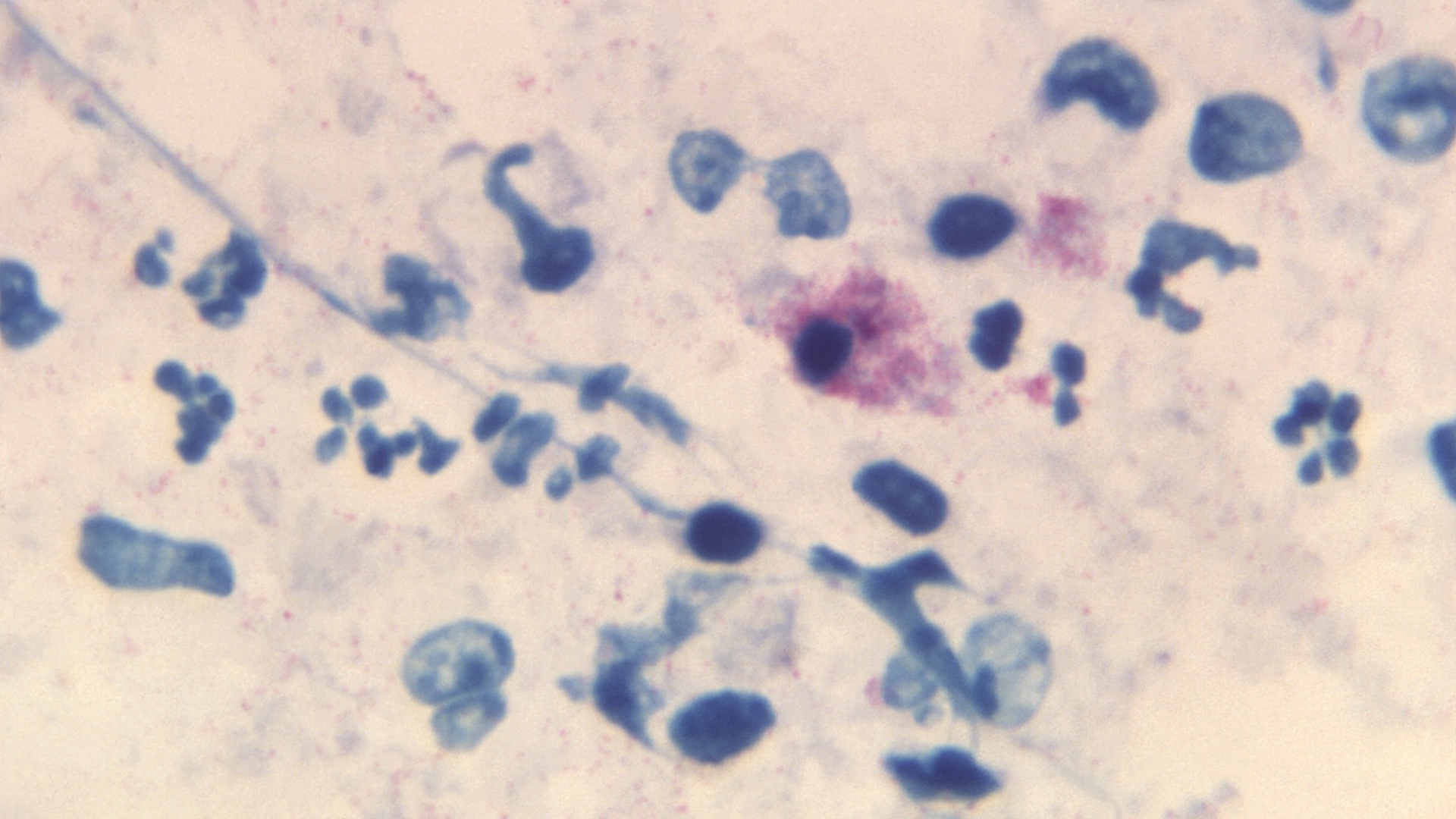
Birds are the primary vectors for psittacosis, also known as parrot fever, and most people get sick after direct contact with a bird or inhaling dust that's contaminated with birds' feathers or feces. The disease is caused by the bacterium Chlamydophila psittaci. Cockatiels, parrots and parakeets often carry the bacteria, which can also affect other types of birds. You may not see any symptoms in the animals, though they can include poor appetite and difficulty breathing. Human symptoms of the infection include dry cough, fever, headache and muscle aches. Your doctor may do a nasal swab or test your spit or blood to confirm if you have it. Once you've got antibiotics, you should be good to go.
29. Q fever
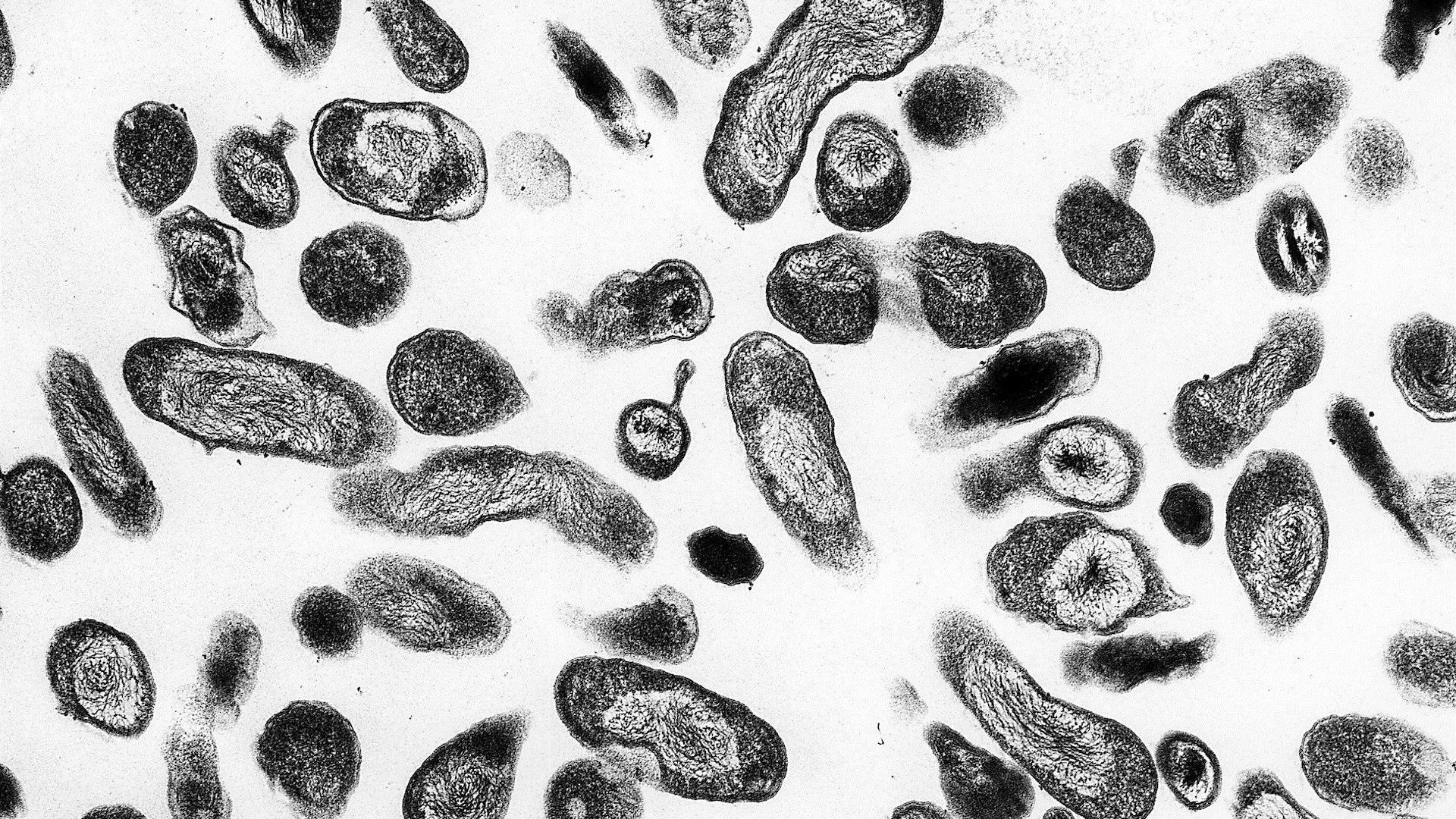
Q fever is a bacterial disease caused by the microbe Coxiella burnetii, which infects cattle, sheep, goats and other animals. The animals may not have symptoms but can shed the bacteria in feces, urine, milk and tissues related to birth. People can get the bacteria through direct contact with an animal or its waste, and also by inhaling dust that's contaminated. Unpasteurized dairy products made from the milk of infected animals can also transmit the bacteria to humans. Symptoms of infection include cough, chills, chest pain, fatigue, headache, nausea, vomiting and diarrhea. It can lead to pneumonia or hepatitis, and, if not treated, it can be fatal. The illness can require months of treatment with antibiotics.
30. Rat bite fever
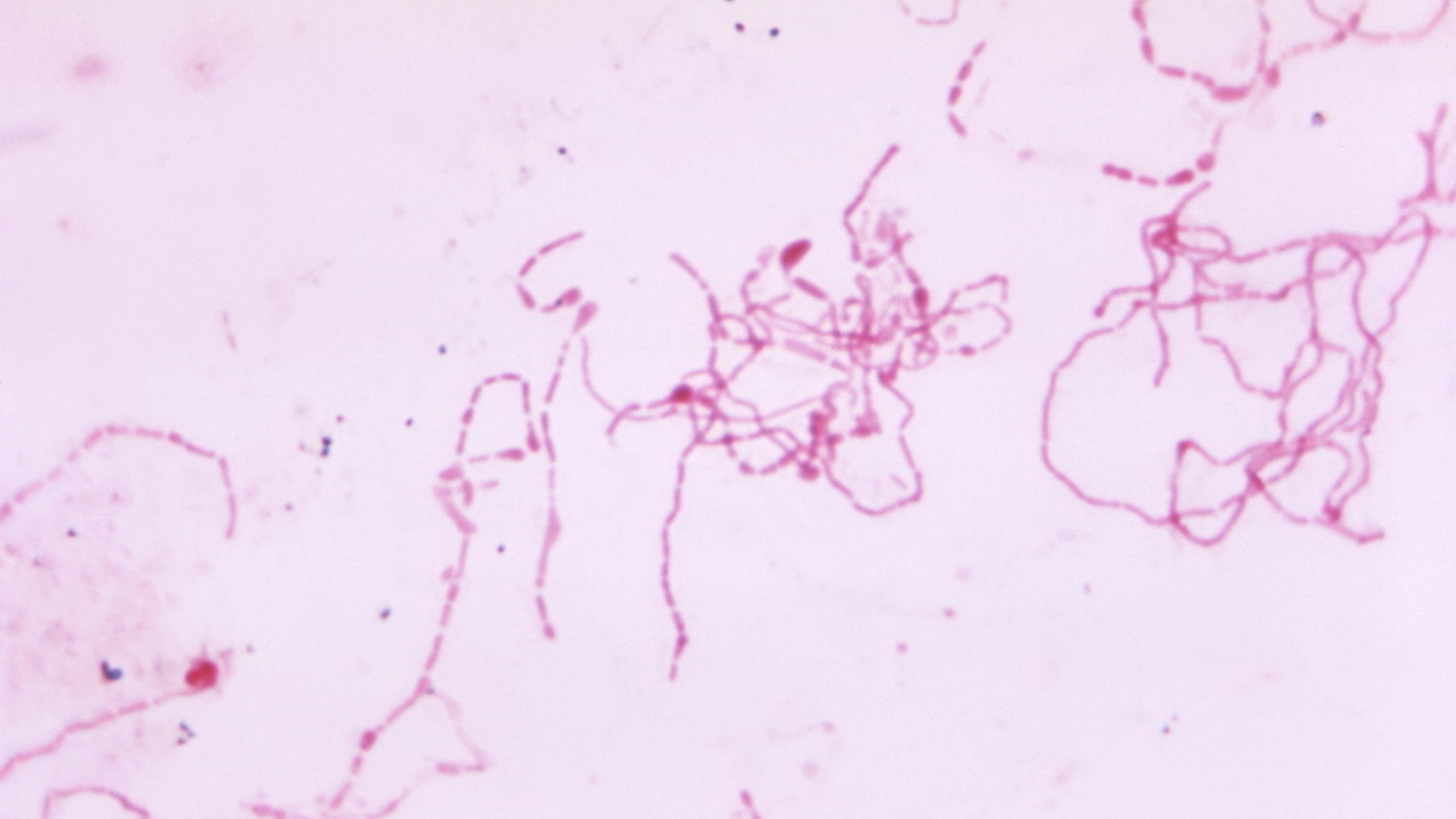
As you can probably infer, rat-bite fever is a bacterial disease that you can get if a rat bites or scratches you. The bacterial culprits are Streptobacillus moniliformis and Spirillum minus. Expect a fever to start suddenly, followed by vomiting and headache, as well as muscle, back and joint pain. Next up, a rash develops on your hands and feet, and your joints start to swell. Mice, squirrels, dogs and cats are just a few animals that can also get the bacteria but they typically don't show symptoms. In the U.S. rat-bite fever is somewhat rare, but some people can be more prone to it than others. Left untreated, it can be fatal. That's why getting an accurate diagnosis and starting antibiotics if you do have it can be so crucial.
31. Ringworm
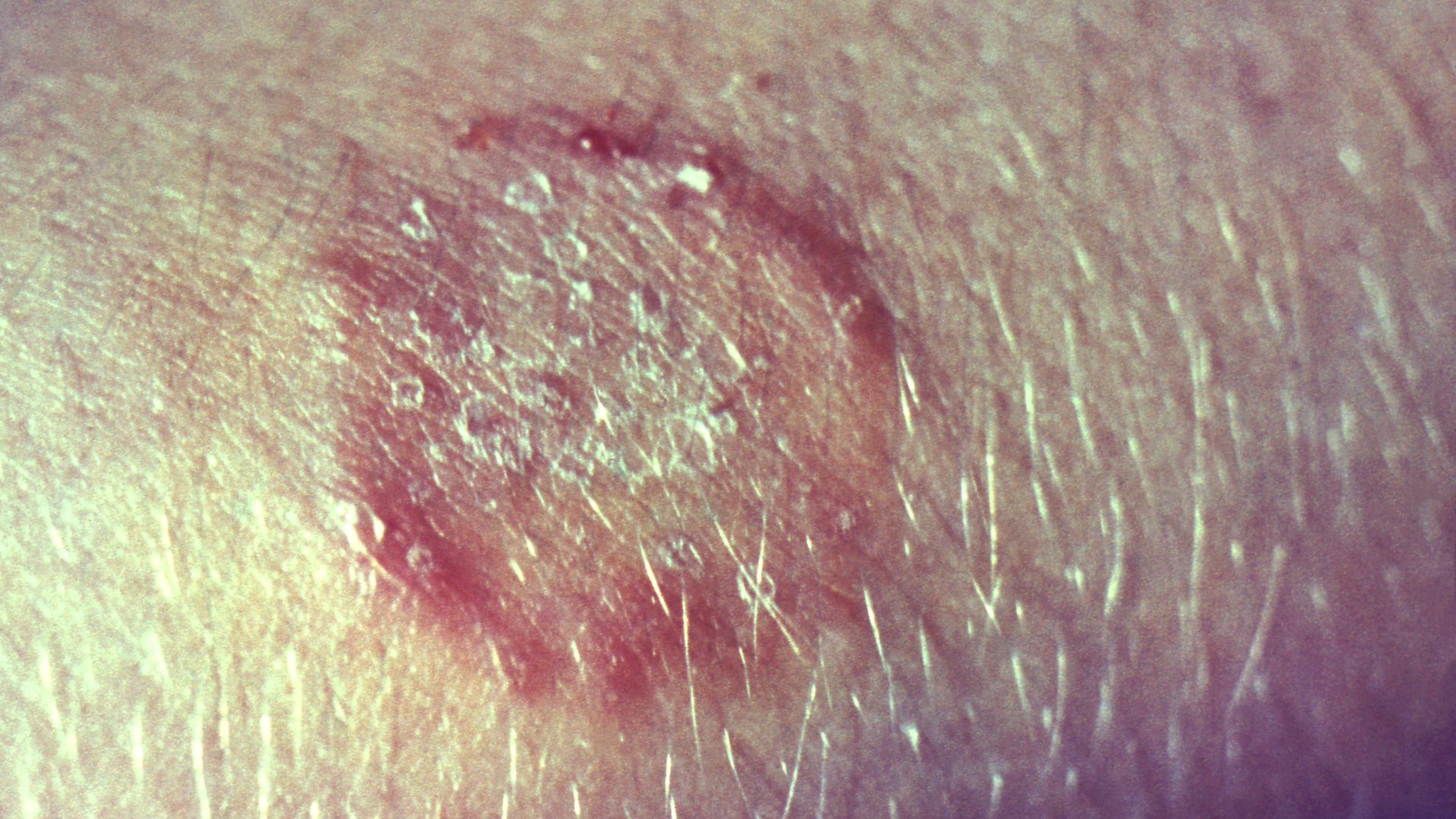
If your precious pet has ringworm, or dermatophytosis, you could get it too. The fungus isn't actually a worm at all. It grows on the skin of dogs, cats, rodents, rabbits, birds, cattle and other animals. You can develop an infection through direct contact with the fungus, and infections can then spread between people. Symptoms include a ring-shaped rash that may be itchy. Your doctor may diagnose an infection just by looking, or by take a scraping of your skin. Ringworm on the foot is known as athlete's foot, and it can be treated with over-the-counter medications. Non-prescription creams can typically treat the infection fairly easily, wherever it may be on the body.
32. MERS

Middle East Respiratory Syndrome (MERS) is a viral respiratory illness that’s relatively new to humans, as it was first reported in 2012. People infected with it typically develop severe respiratory illnesses that involve fever, cough, and shortness of breath. An estimated 30% to 40% of those affected die. The virus can spread to humans from infected dromedary camels (Camelus dromedarius), who likely first caught the virus from bats. People can also spread the virus to each other through close contact and respiratory droplets, if they cough. That’s why you can prevent it using normal methods you would to prevent colds. The viral infection doesn’t have a specific treatment.







